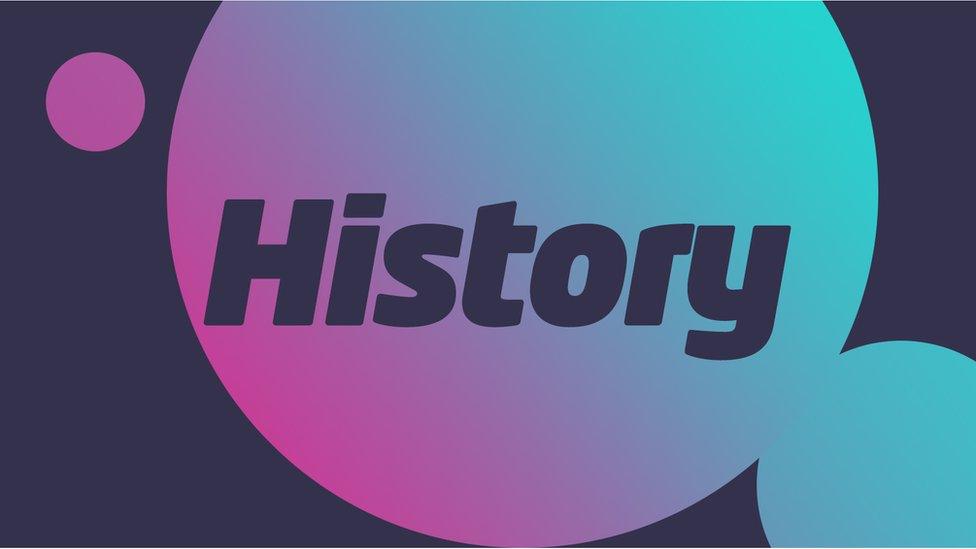What is the Mayflower and why is it celebrated 400 years later?
- Published
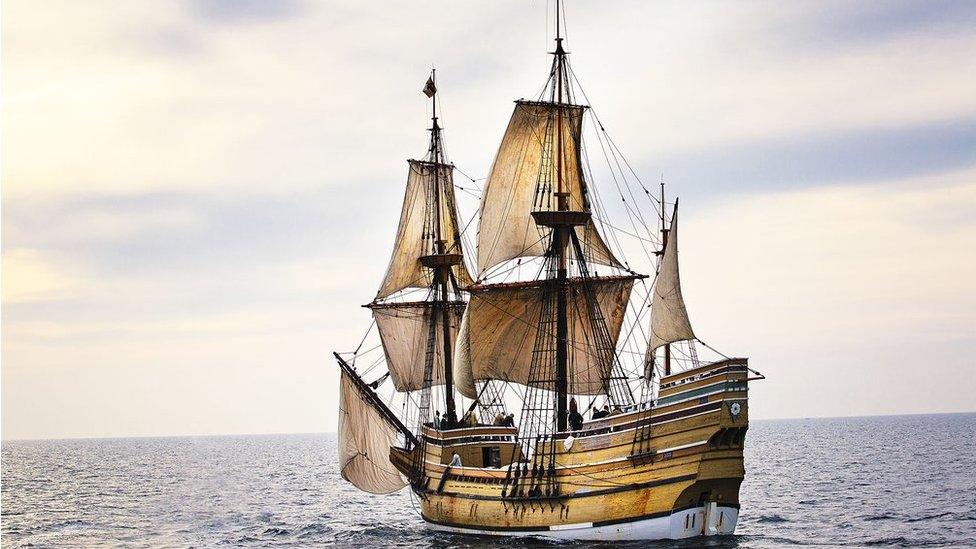
Ever heard Americans talking about the pilgrims or Thanksgiving? Well it's all down to a ship that left England on this day 400 years ago.
On 16 September 1620, the ship called the Mayflower set sail from Plymouth - on board were more than 100 passengers all hoping to start a new life in America.
These early settlers would become known as the pilgrims, and their arrival in North America would shape the history of the nation for generations.
Passengers on the Mayflower included men, women and children from England and the city of Leiden in Holland.
The passengers were divided into groups known as 'Saints' and 'Strangers'.
The Strangers came from all backgrounds including tradesmen seeking a new life and new land.
However a significant number of those on the ship were 'Saints' also known as 'Separatists' or 'Puritans', a group of people who wanted to live a life free from the Church of England to start a new church in America.
They thought that the new church needed to be stricter to keep it as far away as possible from the old Catholic traditions.
A particular group of Puritans decided that England would never give them the chance to follow their religion in the way they wanted, so they left.
The Christian Church became divided into Catholic and Protestant through a movement called the Reformation.
King Henry VIII created the Church of England after forcing a split from the Roman Catholic Church in 1534. He did this because he wanted permission to divorce his first wife Catherine of Aragon.
These changes produced a number of situations where groups of people decided to migrate because of their religion.
What's the connection with Holland?
Led by a man named William Brewster, many of the Separatists had already fled England some years earlier.
In 1608 a group had moved from the village of Scrooby in Nottinghamshire to the Dutch city of Leiden.
In Holland the Separatists were free to worship as they liked, but life was difficult because as migrants they could only get difficult and low paid jobs. The deeply religious community also became concerned that the younger generation were getting "drawn away," by a more relaxed culture in Holland.
When England's King James I negotiated an alliance with Holland against Spain, he set the condition that separatist church congregations must be banned in Holland.
It was time for the Leiden Separatists to leave - so they bought a small ship called the Speedwell and sailed to Southampton to meet the Mayflower before both ships could journey to the New World.

On 15 August 1620, the two boats set off from Southampton on their journey to America, but almost immediately the Speedwell began to leak and wasn't seaworthy. So the ships travelled back to port in Plymouth.
Passengers from the Speedwell squeezed themselves and their belongings onto the Mayflower, a cargo ship no more than 100 feet long and 24 feet wide. To put that into context it was smaller than the size of a penalty box on a football pitch!
Also on board were the crew, servants and unaccompanied orphaned children. Even dogs, cats and birds were crammed on board the vessel.
The Mayflower set off on her journey on 16 September 1620.
The delay in travelling meant the Atlantic ocean between England and America was very rough and stormy.
Many of the passengers were seasick and could barely stand up on the boat, the waves were very high and the sea was so rough that one passenger was swept overboard.
Life on the ship was extremely difficult with people crammed together like sardines. The cabins were small, making it a difficult place to sleep or live in. The lower decks where so small that anyone over five feet tall would not have been able to stand upright.
Eventually, after a difficult two months, the Mayflower made it to America.
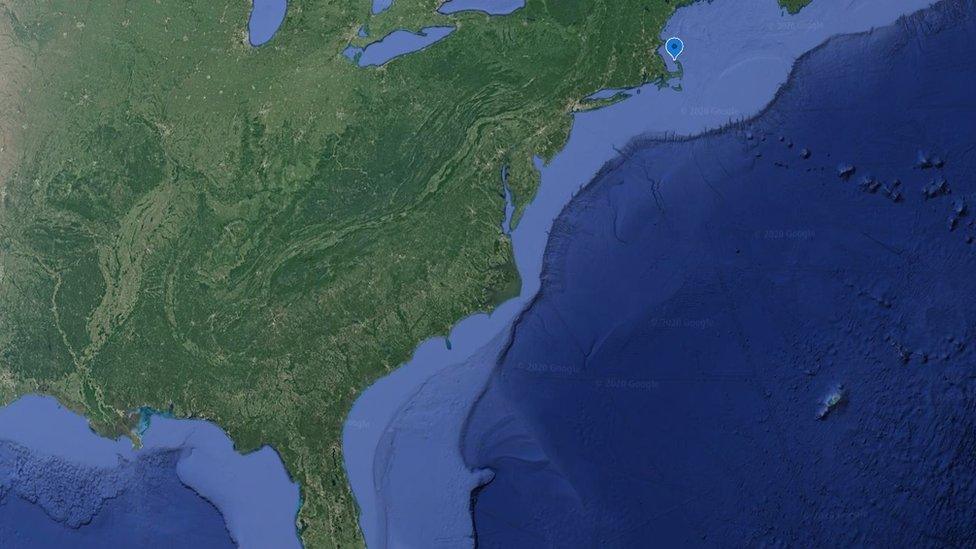
The pilgrims travelled to a place called Cape Cod in the north east of America
Life in the New World
The Mayflower first landed in America in November 1620, at Cape Cod which is now known as Provincetown, Massachusetts in the area of New England.
It was not the first time that an English ship had arrived in North America with the aim of setting up a colony. In 1607, English settlers founded Jamestown in what is now the US state of Virginia.
Virginia was The Mayflower's original destination, but strong winds and bad weather had prevented the crew from sailing further south.
Before going ashore, Pilgrim leaders drafted something called the Mayflower Compact to avoid arguments and fighting.
Pilgrim leader William Bradford wrote, "several strangers made discontented and mutinous speeches".
The Pilgrims knew if something wasn't done quickly it could be every man, woman and family for themselves.
Signed by 41 men on board, the compact was an agreement to cooperate for the general good of the colony. The pilgrims would deal with issues by voting, establish laws with decisions made democratically by the majority.
A tough start
The first winter for the settlers in the New World proved to be deadly. Disease had spread and poor living conditions on the boat and a severe lack of nutrition had resulted in several passengers suffering from scurvy, which causes severe weakness due to a lack of sunlight and proper food.
The winter was harsh, the settlers didn't have the correct clothes or equipment to deal with the conditions. The frozen land also meant they couldn't grow crops.
The result was that around half of the passengers and half of the crew did not survive.
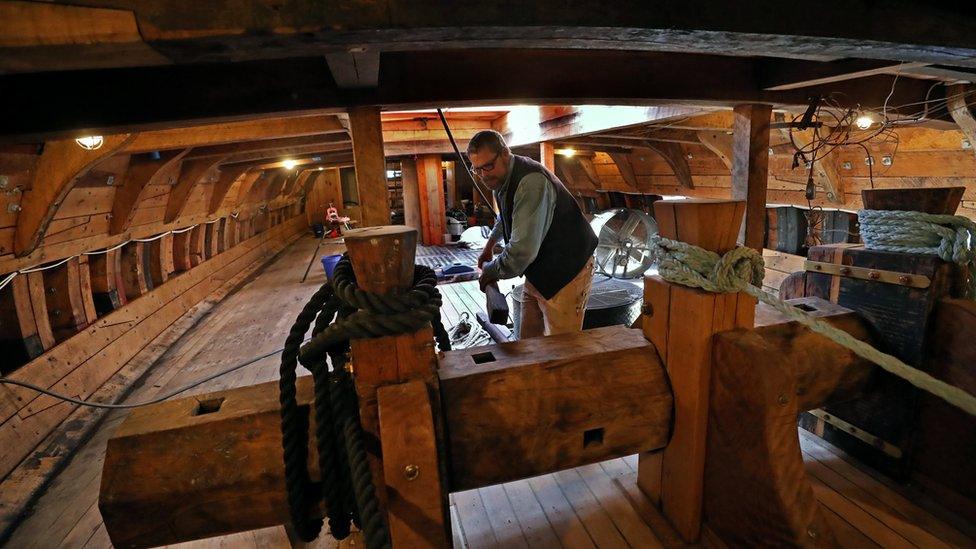
A replica of the Mayflower shows just how cramped the boat was
Native Americans
The arrival of the colonists to America had a huge impact on Native Americans who had to share, or give up the land they had called home for centuries.
When the Mayflower pilgrims arrived, they tried to find a place to set up their new colony, searching much of the coastline including the area now known as Plymouth, Massachusetts.
During their search they found buried corn, which they took back to the ship.
But in finding the corn, they also found graves.
The pilgrims had stumbled upon an empty village known as Patuxet, it had been abandoned following an outbreak of disease.
This was a legacy of the early European settlers who had passed disease onto Native American people. The illness was new for the indigenous people living in North America, their bodies weren't able to fight the diseases, nor did they have the medicines to make themselves better.
The Native American communities referred to the illness as 'the Great Dying'.
Unsurprisingly pilgrims faced some hostility from Native Americans such as the Nauset tribe, who fired arrows at the settlers, having lost friends and family to the European disease.
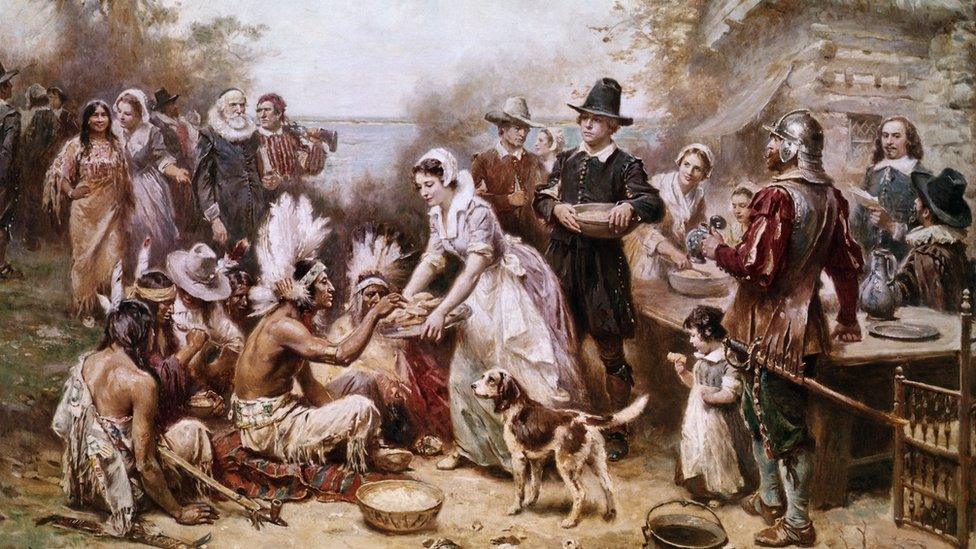
This painting shows the first Thanksgiving feast between the pilgrims and the Wampanoag
Thanksgiving
However, in March 1621, the pilgrim colony was visited by a man named Samoset, a chief from the Wampanoag tribe, a community whose land the pilgrims had settled on. He surprised the colonists as he could speak English and wanted to form a truce.
Samoset introduced the pilgrims to Massasoit Sachem, the leader of the Wampanoag, he wanted to make friends with the settlers in the hope that they would provide help against a rival Massachusetts tribe, called the Narragansett.
The Native American people taught the pilgrims how to grow corn on unfamiliar land and after a successful harvest in autumn 1621, the 53 remaining settlers invited their Wampanoag allies to join them for a massive feast.
The feast was later known as the first ever Thanksgiving, a holiday that is now celebrated each year in the US on the fourth Thursday in November.
Unfortunately good relations between Native Americans and pilgrims did not last long.
Violence between European settlers and Native Americans increased during the 1600s.
In 1675, Massasoit's grandson Metacom, known as 'King Phillip' by the English, led the Wampanoag against their former allies and attacked the colony.
The result was a 14-month conflict which ended with Metacom being killed and the Wampanoag tribe being almost completely wiped-out.
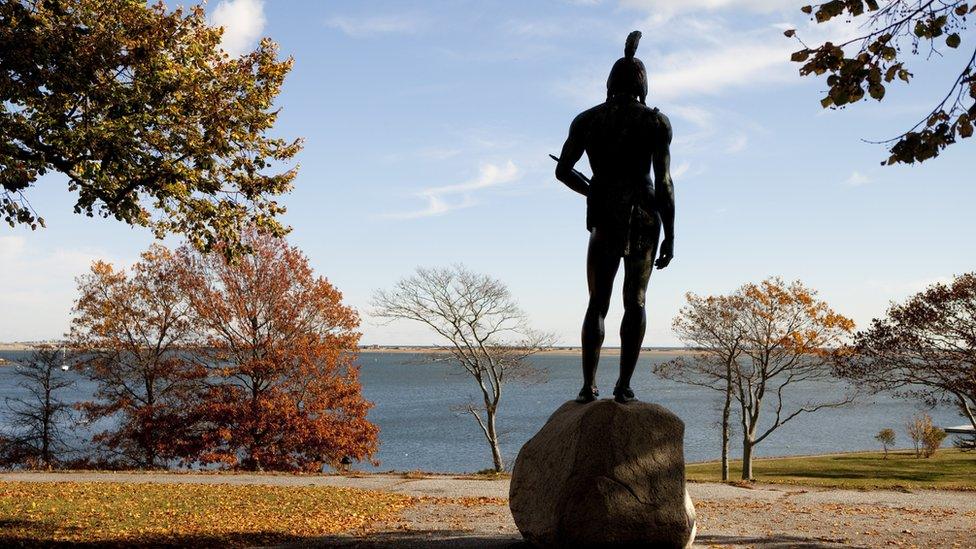
A statue of Massasoit Sachem, the leader of the Wampanoag stands on a hill overlooking Plymouth Harbor in Massachusetts
Four hundred year celebrations
Today the Mayflower is remembered as a cultural icon in the history of the United States.
It is estimated that up to tens of millions of Americans have at least one ancestor who was among the group of early settlers who arrived in the country 400 years ago.
The day will also be remembered for the colonisation of North America that had a huge impact on the way of life and culture of native Americans living in the US today.
Events to mark the 400th Anniversary are planned in the US, England and in Holland.
- Published28 November 2024

- Published14 July 2020
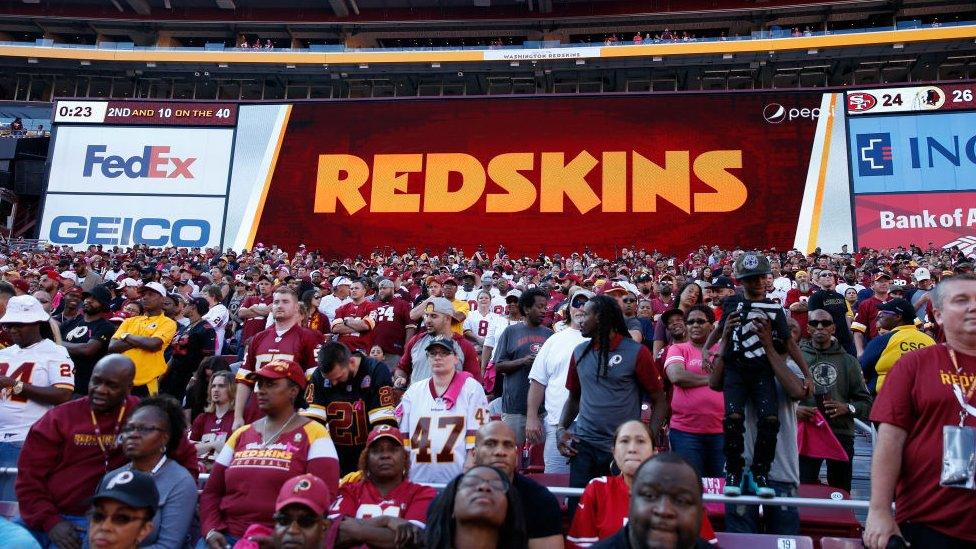
- Published19 May 2020
